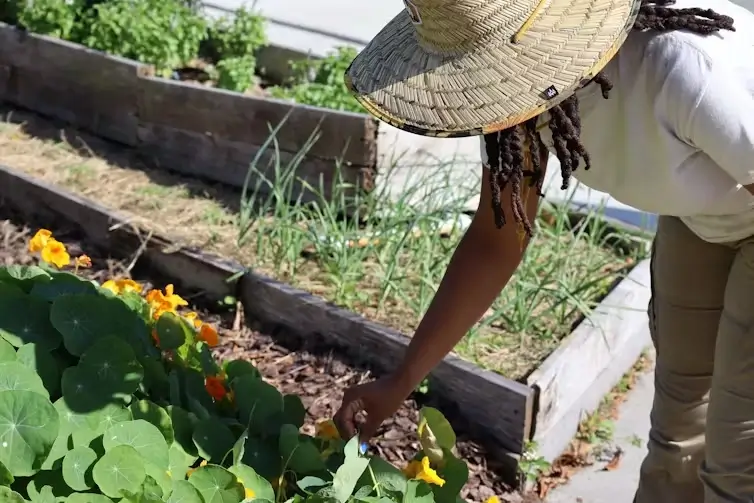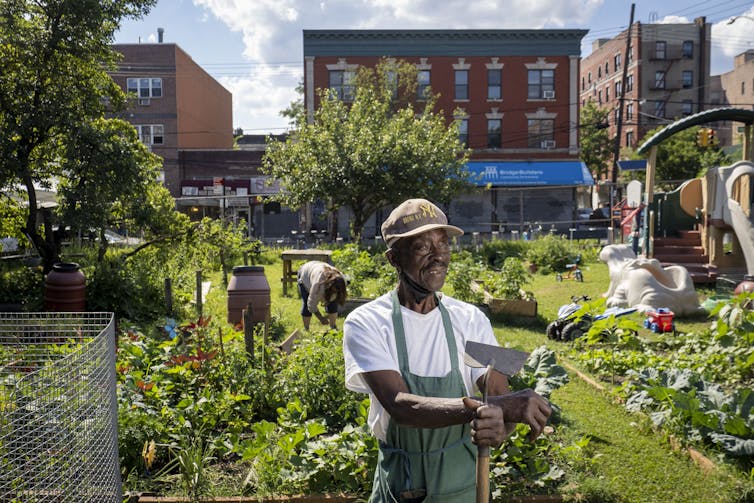Urban Agriculture isn’t as Climate-Friendly as It Seems. These Best Practices Can Help.
Urban agriculture has many community benefits, but it isn’t always better for the climate than conventional agriculture—unless you follow these practices.
Urban Agriculture isn’t as Climate-Friendly as It Seems. These Best Practices Can Help.
Urban agriculture has many community benefits, but it isn’t always better for the climate than conventional agriculture—unless you follow these practices.

Recycling construction materials and water can make urban agriculture more sustainable.by Lauren Moore/USDA.
Urban agriculture is expected to be an important feature of 21st century sustainability and can have many benefits for communities and cities, including providing fresh produce in neighborhoods with few other options.
Among those benefits, growing food in backyards, community gardens or urban farms can shrink the distance fruits and vegetables have to travel between producers and consumers – what’s known as the “food mile” problem. With transportation’s greenhouse gas emissions eliminated, it’s a small leap to assume that urban agriculture is a simple climate solution.
But is urban agriculture really as climate-friendly as many people think?
Our team of researchers partnered with individual gardeners, community garden volunteers and urban farm managers at 73 sites across five countries in North America and Europe to test this assumption.
We found that urban agriculture, while it has many community benefits, isn’t always better for the climate than conventional agriculture over the life cycle, even with transportation factored in. In fact, on average, the urban agriculture sites we studied were six times more carbon intensive per serving of fruit or vegetables than conventional farming.
However, we also found several practices that stood out for how effectively they can make fruits and vegetables grown in cities more climate-friendly.
What makes urban ag more carbon-intensive?
Most research on urban agriculture has focused on a single type of urban farming, often high-tech projects, such as aquaponic tanks, rooftop greenhouses or vertical farms. Electricity consumption often means the food grown in these high-tech environments has a big carbon footprint.
We looked instead at the life cycle emissions of more common low-tech urban agriculture – the kind found in urban backyards, vacant lots and urban farms.
Our study, published Jan. 22, 2024, modeled carbon emissions from farming activities like watering and fertilizing crops and from building and maintaining the farms. Surprisingly, from a life cycle emissions perspective, the most common source at these sites turned out to be infrastructure. From raised beds to sheds and concrete pathways, this gardening infrastructure means more carbon emissions per serving of produce than the average wide-open fields on conventional farms.

However, among the 73 sites in cities including New York, London and Paris, 17 had lower emissions than conventional farms. By exploring what set these sites apart, we identified some best practices for shrinking the carbon footprint of urban food production.
1) Make use of recycled materials, including food waste and water
Using old building materials for constructing farm infrastructure, such as raised beds, can cut out the climate impacts of new lumber, cement and glass, among other materials. We found that upcycling building materials could cut a site’s emissions 50% or more.
On average, our sites used compost to replace 95% of synthetic nutrients. Using food waste as compost can avoid both the methane emissions from food scraps buried in landfills and the need for synthetic fertilizers made from fossil fuels. We found that careful compost management could cut greenhouse gas emissions by nearly 40%.
Capturing rainwater or using greywater from shower drains or sinks can reduce the need for pumping water, water treatment and water distribution. Yet we found that few sites used those techniques for most of their water.
2) Grow crops that are carbon-intensive when grown by conventional methods
Tomatoes are a great example of crops that can cut emissions when grown with low-tech urban agriculture. Commercially, they are often grown in large-scale greenhouses that can be particularly energy-intensive. Asparagus and other produce that must be transported by airplane because they spoil quickly are another example with a large carbon footprint.
By growing these crops instead of buying them in stores, low-tech urban growers can reduce their net carbon impact.
3) Keep urban gardens going long term
Cities are constantly changing, and community gardens can be vulnerable to development pressures. But if urban agriculture sites can remain in place for many years, they can avoid the need for new infrastructure and keep providing other benefits to their communities.

Urban agriculture sites provide ecosystem services and social benefits, such as fresh produce, community building and education. Urban farms also create homes for bees and urban wildlife, while offering some protection from the urban heat island effect. The practice of growing food in cities is expected to continue expanding in the coming years, and many cities are looking to it as a key tool for climate adaptation and environmental justice. We believe that with careful site design and improved land use policy, urban farmers and gardeners can boost their benefit both to people nearby and the planet as a whole.
Jason Hawes is a Ph.D. Candidate in Resource Policy and Behavior at the University of Michigan; Benjamin Goldstein is Assistant Professor of Sustainable Systems at the University of Michigan, and Joshua Newell is Professor of Environment and Sustainability at the University of Michigan.
This article is republished from The Conversation under a Creative Commons license. Read the original article.
Follow us
This work is licensed under a Creative Commons Attribution-NoDerivatives 4.0 International License.
Want to republish a Modern Farmer story?
We are happy for Modern Farmer stories to be shared, and encourage you to republish our articles for your audience. When doing so, we ask that you follow these guidelines:
Please credit us and our writers
For the author byline, please use “Author Name, Modern Farmer.” At the top of our stories, if on the web, please include this text and link: “This story was originally published by Modern Farmer.”
Please make sure to include a link back to either our home page or the article URL.
At the bottom of the story, please include the following text:
“Modern Farmer is a nonprofit initiative dedicated to raising awareness and catalyzing action at the intersection of food, agriculture, and society. Read more at <link>Modern Farmer</link>.”
Use our widget
We’d like to be able to track our stories, so we ask that if you republish our content, you do so using our widget (located on the left hand side of the article). The HTML code has a built-in tracker that tells us the data and domain where the story was published, as well as view counts.
Check the image requirements
It’s your responsibility to confirm you're licensed to republish images in our articles. Some images, such as those from commercial providers, don't allow their images to be republished without permission or payment. Copyright terms are generally listed in the image caption and attribution. You are welcome to omit our images or substitute with your own. Charts and interactive graphics follow the same rules.
Don’t change too much. Or, ask us first.
Articles must be republished in their entirety. It’s okay to change references to time (“today” to “yesterday”) or location (“Iowa City, IA” to “here”). But please keep everything else the same.
If you feel strongly that a more material edit needs to be made, get in touch with us at [email protected]. We’re happy to discuss it with the original author, but we must have prior approval for changes before publication.
Special cases
Extracts. You may run the first few lines or paragraphs of the article and then say: “Read the full article at Modern Farmer” with a link back to the original article.
Quotes. You may quote authors provided you include a link back to the article URL.
Translations. These require writer approval. To inquire about translation of a Modern Farmer article, contact us at [email protected]
Signed consent / copyright release forms. These are not required, provided you are following these guidelines.
Print. Articles can be republished in print under these same rules, with the exception that you do not need to include the links.
Tag us
When sharing the story on social media, please tag us using the following: - Twitter (@ModFarm) - Facebook (@ModernFarmerMedia) - Instagram (@modfarm)
Use our content respectfully
Modern Farmer is a nonprofit and as such we share our content for free and in good faith in order to reach new audiences. Respectfully,
No selling ads against our stories. It’s okay to put our stories on pages with ads.
Don’t republish our material wholesale, or automatically; you need to select stories to be republished individually.
You have no rights to sell, license, syndicate, or otherwise represent yourself as the authorized owner of our material to any third parties. This means that you cannot actively publish or submit our work for syndication to third party platforms or apps like Apple News or Google News. We understand that publishers cannot fully control when certain third parties automatically summarize or crawl content from publishers’ own sites.
Keep in touch
We want to hear from you if you love Modern Farmer content, have a collaboration idea, or anything else to share. As a nonprofit outlet, we work in service of our community and are always open to comments, feedback, and ideas. Contact us at [email protected].by Jason Hawes, Benjamin Goldstein and Joshua Newell, The Conversation, Modern Farmer
January 22, 2024
Modern Farmer Weekly
Solutions Hub
Innovations, ideas and inspiration. Actionable solutions for a resilient food system.
ExploreExplore other topics
Share With Us
We want to hear from Modern Farmer readers who have thoughtful commentary, actionable solutions, or helpful ideas to share.
SubmitNecessary cookies are absolutely essential for the website to function properly. This category only includes cookies that ensures basic functionalities and security features of the website. These cookies do not store any personal information.
Any cookies that may not be particularly necessary for the website to function and are used specifically to collect user personal data via analytics, ads, other embedded contents are termed as non-necessary cookies.
What aspects of urban agriculture contribute to its carbon intensity, particularly in low-tech settings?
Regard Telkom University
This study has received massive attention, with the results being accepted uncritically. It is deeply flawed, however, because it compares apples to oranges. Some examples: Conventional farmers are professionals, while most urban farmers are not. The infrastructure of conventional agriculture is energy intensive to create, operate and maintain because of its scale and , especially as it becomes more computerized A sizeable amount of the food produced by conventional agriculture does not go directly to eaters’ plates The number of urban farms at this point is too small to have a significant global environmental impact Sometimes data-driven research can benefit from an… Read more »
This article is completely confusing. The language is confusing. Is it trying to say that the wood used to make raised boxes and other infrastructure makes urban gardening more carbon intensive then regular farming? I’m failing to understand how growing food in a backyard is more carbon intensive then going to the grocery store. Is this what it’s trying to say. So confusing…!
It seems like this article contradicts itself – of course urban agriculture is going to be lower emissions and a great addition to conventional farming.